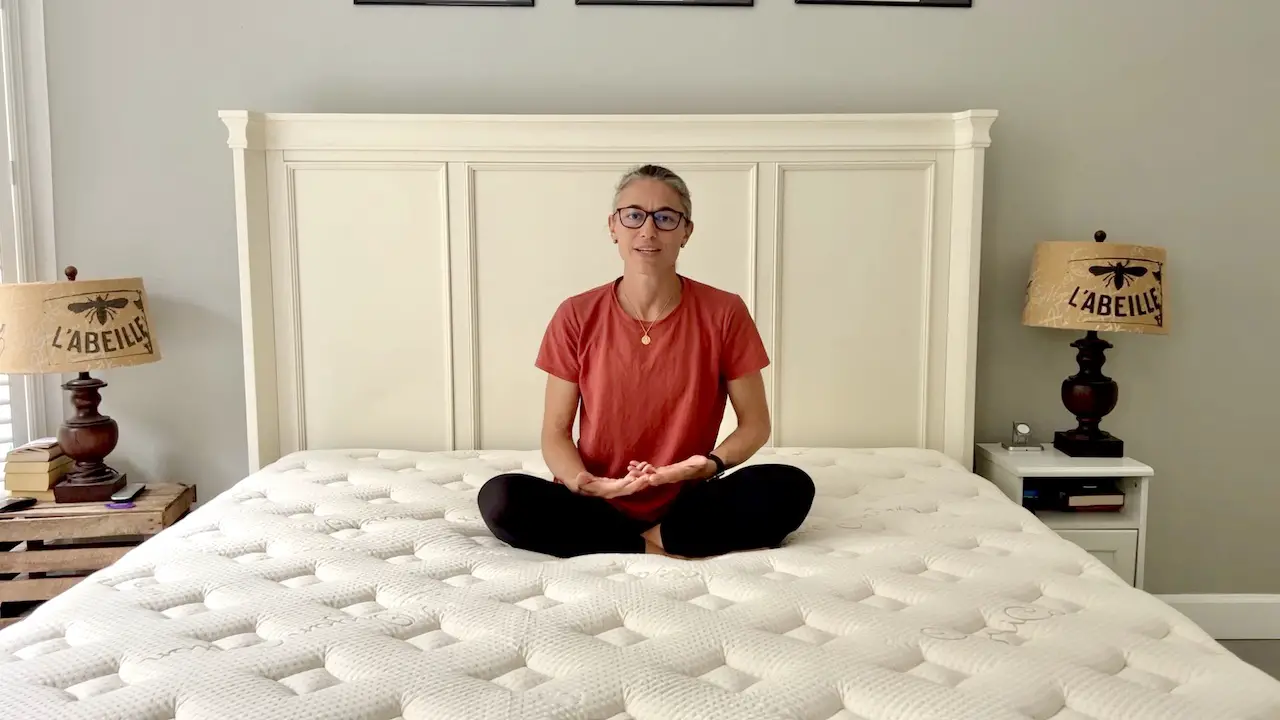BEST WAYS TO SLEEP WHILE PREGNANT
Including Trimester-Specific Tips
Pregnancy is an exciting and transformative time, but it often comes with challenges—especially when it comes to getting restful sleep. As a mother of 4 myself, I understand the challenges that comes with pregnancy sleep, and how important it is to be rested before labor and the welcoming of your new bundle.
While many expectant moms find it increasingly difficult to sleep while pregnant, whether due to physical discomfort, hormonal changes, or heightened stress, it is essential to find the right sleeping positions, routines, and bedding to improve rest.
Let’s take a closer look at the best ways to sleep while pregnant, including safe sleep positions, sleep accessories, lifestyle adjustments, and product recommendations to help you rest more comfortably during each stage of pregnancy.
Table of Contents
Why Sleep Changes During Pregnancy
Pregnancy affects nearly every system in the body, and sleep is no exception. Many pregnant women experience:
Hormonal shifts that alter circadian rhythms and increase nighttime awakenings.
Frequent urination due to increased blood flow and pressure on the bladder.
Heartburn and indigestion that worsen when lying down.
Physical discomfort as the baby grows, putting pressure on the back, hips, and abdomen.
Anxiety and stress that may cause difficulty falling or staying asleep.
Understanding these challenges is the first step to improving how you sleep while pregnant. Can you identify some of those sources to your poor sleep?
Best Sleep Positions While Pregnant
One of the most common questions expecting mothers have is: What position is best to sleep in while pregnant?
Sleeping on Your Side
Most literature, as well as doctors, typically recommend sleeping on your side, especially the left side, during pregnancy. This position improves blood circulation, reduces pressure on vital organs, and promotes better oxygen flow to the baby.
Left side: Often considered the best position since it enhances kidney function and helps reduce swelling.
Right side: Also safe, though it may slightly increase pressure on certain blood vessels.
Sleeping on Your Back
While some women find back sleeping comfortable, it is generally discouraged in later pregnancy (2nd and 3rd trimesters). Lying flat can compress the inferior vena cava (the large vein carrying blood back to the heart), potentially reducing blood circulation. You may find yourself short of breath while laying on your back during pregnancy.
Sleeping on Your Stomach
Early in pregnancy, stomach sleeping is safe if comfortable, but as the bump grows, it becomes impractical and uncomfortable. Specialized pillows or wedge cushions may help provide some stomach support in the transition phase and it is recommended to stop sleeping on your stomach around the 3rd or 4th month of pregnancy.
Trimester-Specific Sleep Tips
First Trimester
Fatigue may be high, so naps can help. If you are able to, lay down for 20 minutes in the middle of the day to recover and benefit from the power of a power nap.
Experiment with side sleeping early to get used to it, especially if you are a back or stomach sleeper. Adding a pillow will help your posture and make side sleeping more comfortable.
Invest in breathable bedding to help with night sweats.
Second Trimester
Discomfort starts to increase as your belly grows. You should now consider shifting to your side.
Use a body pillow for extra support. It will bring full-body comfort as you can slide it under your head, along your back for support, and bring it between your legs to lessen the load on your lower back.
Elevate your head slightly to reduce heartburn.
Third Trimester
Side sleeping becomes essential. Favor your left side to maximal blood flow to your baby!
Place a pillow between the knees to align hips. A full-body pillow can be a game changer – this is our favorite and the one I couldn’t sleep without in my last pregnancy.
Try propping the upper body to ease breathing difficulties.
Each trimester brings unique challenges, but making adjustments will help you sleep while pregnant more comfortably.
The Role of Pillows in Pregnancy Sleep
One of the best tools to improve sleep during pregnancy is the right pillow setup. They provide support and comfort, and can allow your body to relax in the proper position for sleep.
Full-Body Pillows
Designed to support the head, neck, belly, back, and knees all at once.
C-shaped or U-shaped pillows are especially efficient at propping your body in the right position for you.
Wedge Pillows
Placed under the belly or behind the back for targeted support.
Great for reducing strain on muscles and joints and to improve symptoms of acid reflux.
Extra Pillows
A standard pillow between the knees improves spinal alignment at a lower cost, as you probably have some laying around the house already.
Elevating the upper body with pillows can reduce snoring and acid reflux.
Using pillows strategically can easily and quickly transform how you sleep while pregnant, reducing aches and improving comfort.
Choosing the Right Mattress to Sleep While Pregnant
Your mattress plays a big role in pregnancy comfort. A mattress that is too firm or too soft can worsen hip, back, and shoulder pain. While you are unlikely to purchase a new pillow for your pregnancy specifically, you may be looking for a new mattress if yours is reaching its end of life.
Features to Look For
Pressure relief: Memory foam and hybrid mattresses contour to the body and relieve joint pain.
Support: Look for a medium-firm mattress that balances comfort with proper spinal alignment.
Cooling properties: Pregnancy often increases body temperature, so breathable materials like latex or gel-infused foams are helpful. This is our favorite cooling mattress.
Motion isolation: Reduces disruptions if you are sharing the bed with a partner. If you sleep on a King-size bed, you may enjoy purchasing a Split-King, which is made of 2 separate TwinXL, virtually cancelling motion transfer from a moving partner.
Adjustable Beds
Pairing your mattress with an adjustable base can be especially beneficial during pregnancy. Elevating the legs helps reduce swelling, while raising the upper body alleviates acid reflux and improves breathing.
Creating a Sleep-Friendly Environment
Your bedroom environment can make or break your ability to sleep while pregnant.
Temperature control: Keep the room cool (around 65–68°F).
Light blocking: Use blackout curtains to improve melatonin production.
Noise reduction: White noise machines or fans can help lull you to sleep by canceling distractions such as a snoring partner or outdoor street noises.
Air quality: Good ventilation supports easier breathing, especially in later pregnancy.
Bedtime Routine for Better Pregnancy Sleep
Establishing a calming bedtime routine can help your body wind down.
Set a consistent schedule: Go to bed and wake up at the same times every day. This will give your body and mind the cues it needs to calmly wind down and gently go to sleep.
Avoid heavy meals and caffeine: Especially in the evening. Consult our list of what not to eat before bed for more information.
Do light stretching or prenatal yoga: Relieves muscle tension. Different exercises can be safely practiced during pregnancy but consult a healthcare provider prior to starting a new routine. This is our guide of when to exercise before bed (not all exercises in this list are pregnancy-safe).
Practice relaxation techniques: Deep breathing, meditation, or gentle reading. It takes only a few minutes to get into a good mental state for sleep.
Limit screen time: Blue light can interfere with melatonin production. Avoid screen time in the bedroom and screens within an hour of going to sleep. Instead, replace with reading a book and meditating.
These habits support not just falling asleep, but staying asleep throughout the night.
Managing Common Pregnancy Sleep Problems
Heartburn and Indigestion
Eat smaller meals earlier in the evening.
Elevate your head with pillows.
Restless Leg Syndrome (RLS)
Stay active during the day.
Consider magnesium-rich foods.
Stretch before bedtime.
Frequent Urination
Limit fluids in the last couple of hours before bed.
Avoid caffeine and alcohol, which increase bladder activity.
Back Pain
Use a supportive mattress.
Place pillows under the belly and between the knees.
By addressing these issues, you’ll find it easier to sleep while pregnant without constant disruptions.
When to Talk to a Doctor
While many sleep challenges are normal during pregnancy, some may signal underlying conditions:
Severe snoring or pauses in breathing (possible sleep apnea).
Intense leg cramps that don’t improve with stretching.
Persistent insomnia despite lifestyle adjustments.
Always consult your healthcare provider if you’re concerned about your sleep quality, or before starting lifestyle or exercise routines.
Best Ways to Sleep While Pregnant - Final Thoughts
Here is a quick summary of what we have discussed above. The below tips to better sleep while pregnant, will help you catch more zzz’s and feel more rested by the time baby arrives:
Side sleeping, especially on the left, is the safest and most comfortable position.
Use body pillows, wedges, and supportive bedding to ease discomfort.
Choose a medium-firm, breathable mattress with good pressure relief.
Create a cool, quiet, and dark environment for better rest. Add cooling bedding that sleeps cool and soft.
Follow a calming bedtime routine and address common sleep issues like heartburn, back pain, and frequent urination.
By making these adjustments, you can improve your ability to sleep while pregnant and give your body the rest it needs during this important time.
Pregnancy may make restful sleep more challenging, but with the right strategies, you can set yourself up for better nights and healthier days. From adopting the best sleeping positions to investing in supportive bedding, small changes can add up to significant improvements. Remember, the goal isn’t just to get through the night, but to give both you and your baby the best possible environment to thrive.
References
- US Department of Health and Human Services. (2019). Sleeping position during early and mid pregnancy does not affect risk of complications, NIH-funded study suggests. Retrieved from https://www.nichd.nih.gov/newsroom/news/092019-pregnancy-sleep-position
- Mount Sinai. Problems sleeping during pregnancy. Retrieved from https://www.mountsinai.org/health-library/selfcare-instructions/problems-sleeping-during-pregnancy
FAQ
Most frequent questions and answers
The best position to sleep while pregnant is on your side, especially the left side, which improves circulation and reduces pressure on major organs.
Sleeping on your back while pregnant is generally not recommended in the second and third trimesters because it can reduce blood flow to you and your baby.
In early pregnancy, it’s safe to sleep on your stomach, but as your bump grows, it becomes uncomfortable and unsafe, so side sleeping is recommended.
Using body pillows, wedge pillows, or extra support between the knees can relieve pressure and help you sleep while pregnant more comfortably.
A medium-firm mattress with good pressure relief, support, and cooling properties can make it much easier to sleep while pregnant.
What is the best position to sleep while pregnant?
The best position to sleep while pregnant is on your side, especially the left side, which improves circulation and reduces pressure on major organs.
Is it safe to sleep on my back while pregnant?
Sleeping on your back while pregnant is generally not recommended in the second and third trimesters because it can reduce blood flow to you and your baby.
Can I sleep on my stomach while pregnant?
In early pregnancy, it’s safe to sleep on your stomach, but as your bump grows, it becomes uncomfortable and unsafe, so side sleeping is recommended.
How can pillows help me sleep while pregnant?
Using body pillows, wedge pillows, or extra support between the knees can relieve pressure and help you sleep while pregnant more comfortably.
What type of mattress is best to sleep while pregnant?
A medium-firm mattress with good pressure relief, support, and cooling properties can make it much easier to sleep while pregnant.
Share this deal with a friend!

Laura Georgieff
Laura is a mother of three who did not sleep through the night for the first 5.5 years of her kids' lives. She is passionate about sleep quality and loves sharing her experience and knowledge of all thing bedding! It is her mission to help you make the best decisions when it comes to sleep and help you get the best deal on the market!






